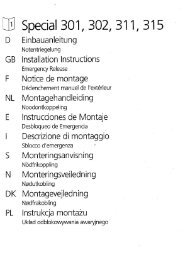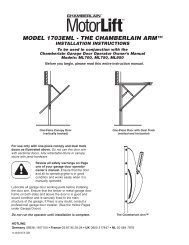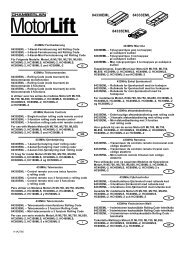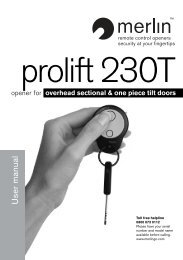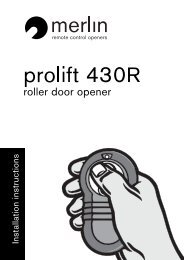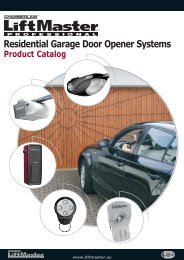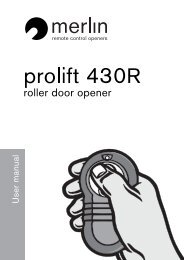JM60-433 - Sparesmaster
JM60-433 - Sparesmaster
JM60-433 - Sparesmaster
- No tags were found...
You also want an ePaper? Increase the reach of your titles
YUMPU automatically turns print PDFs into web optimized ePapers that Google loves.
25 /1. 1 (21 2. : ? 3. //5. “”6. /7. 8. 219. 10. :11. 12. 1314 13. 14. 15. 16. “” 4-CN4. 5
4ASSEMBLY SECTION5Assemble RailPlace Rail pieces (1) on a flat surface for assembly. Take specialnote of the raised line on the Rail pieces (4) these lines MUST lineup in order for the Rail to fit together properly. All three Railsections are interchangeable. Slide Rail Braces (2) into slots on thesides of Rail. Make sure small tabs on Rail Braces (3) are upagainst top lip of Rail. Connect Rail by sliding other end of bracesinto next Rail. Be sure the raised lines that run down Rail sections(4) line up. Tap Rail assembly (5) on a piece of wood (6) until Railsections are flush. Repeat for final Rail section.Vibration Reduction Kit:Pads are to be placed inside the rail close to the operator powerhead. Two pads on each side. Two half pads at the bottom of therail. Clean rail where pads will be placed. WORK CLEAN! Removegrease or any dirt from rail otherwise pads won’t stick.6Assemble Cable Pulley BracketInsert Carriage Bolt (1) though square hole in Cable Pulley Bracket(4). Remove Chain/Cable assembly (3) from carton. Wrap Cablearound Cable Pulley (2) and insert Pulley into Bracket (NOTE:Make sure the Bracket is assembled in position shown). Slide pin(5) through holes in Cable Pulley Bracket and Cable Pulley. NOTE:Trolley with Magnet (6) MUST be installed in the position shown.7Insert Chain/Cable into RailSlide Cable Pulley Bracket (1) into Rail assembly (3), be sure toinsert Cable Pulley Bracket as shown. Push Cable Pulley Brackettoward front of Rail and slide Inner Trolley (2) into Rail assembly.Magnet (4) MUST be installed in position shown or unit will notfunction properly.8Attach Trolley to RailTurn Rail assembly over. Slide Outer Trolley (1) into Rail assembly(2), be sure the end with Door Arm Hole (3) is heading in directionof door (4). Slide Outer Trolley down Rail until it engages with InnerTrolley.9Attach Rail to UnitTurn Rail assembly over. Wrap Chain around Drive Sprocket (1).Slide Rail assembly (2) toward unit and into slots on top of unit.Attach C-Bracket (3) on rail and secure with screws (4) as shown.Push Cable Pulley Bracket forward making Chain tight on sprocket.Chain MUST engage teeth on Drive Sprocket.10Completed InstallationAs you proceed with the assembly, installation andadjustment procedures in this manual, you may find it helpfulto refer back to this illustration of a completed installation.(1) Cable Pulley Bracket(2) Trolley(3) Chain/Cable Assembly(4) Rail(5) Hanging Bracket(6) Power Cord(7) Opener(8) Light Lens(9) Manual ReleaseRope & Handle(10) Door Arm(11) Door Bracket(12) Header BracketAttach Header BracketTurn Rail and Unit assembly over. Slide Cable Pulley Bracket (2)toward front end of Rail (3). Be careful Chain does not come offDrive Sprocket on unit or become twisted. Slide Carriage Bolt (5)into Header Bracket (1). Secure with Lock Nut (4). Tighten Nut untilChain does not droop below rail. Do NOT over tighten.ASSEMBLY OF YOUR OPENER IS NOW COMPLETE.INSTALLATION SECTIONWear protective goggles when working overhead to protect youreyes from injury. Disengage all existing garage door locks to avoiddamage to garage door. To avoid serious personal injury fromentanglement, remove all ropes connected to garage door beforeinstalling opener. Installation of this product shall comply withZH1/494, VDE 0700 Part 238, and VDE 0700 Part 1. It isrecommended that the opener be installed 2.1m (7 feet) or moreabove the floor where space permits.11Find Center of GarageMark center of door (1). Extend line onto ceiling (2).121314Mount Header BracketClose door providing a support for header bracket.A. Preferred:Locate the vertical center line (4) and the point that was markedin step 13. Place bottom of Header bracket (1) over this point.Mark holes for Header Bracket (5) that meet the wall. Forconcrete walls drill 8mm pilot holes. Insert Concrete Anchors (2)and secure Header Bracket to Header Wall with Lag Screws (3).For wood walls, drill 4mm pilot holes and secure header bracketwith Lag Screws.B. If Necessary:Locate center line on ceiling (4) center Header Bracket overcenter line. Mark and drill pilot holes for concrete or woodceilings as in A above. Tighten all nuts and bolts securely.15Fasten Door BracketA. Place Door Bracket (2) on the top of the door (3) and centerover Vertical Center Line (1). Mark the two rear top holes. Drill4mm holes.B. Mark the two top front holes. Drill 4mm holes. Fasten DoorBracket (2) to the top of the door (3) using Screws (4)NOTE: If you have a Hörmann Door and for some other doors it isrecommended to place two screws (5) in the front bottom holes(Not Provided).16Position OpenerOpen Door (3) to its highest point of travel (1) measure 20mmabove this point and mark on Header Wall (2) the bottom of theRail (4) should be no more than 20mm above highest point oftravel of the door (1). NOTE: If door spring is in the way install unitdirectly above spring. Clearance between highest point of traveland Rail should not exceed 50mm and can be zero whenclearance between door and ceiling is only 30mm.Hang OpenerBend Hanging Brackets (1) so they are flat against ceiling.Measure distance from Header Bracket to Ceiling MountingBracket Bolts. Mark length on ceiling starting at the Header Wall,along this point is where the unit will be mounted. Lift door to fullopen position, rest opener on door. Insert Square Head Screws (A)into Rail assembly (B) approximately 120mm from end of Rail nearmotor unit. Slide Hanging Brackets on to Square Head Screws andsecure Brackets with Nuts (5). In this process the Square HeadScrews hook into slots on the sides of rail. (C)For concrete ceilings, drill 8mm pilot holes into ceiling and insertConcrete Anchors (2). Secure Hanging Brackets to ceiling with LagScrews (3). For wood ceilings, drill 4mm pilot holes and securewith Lag Screws (3).Optional: A second set of hanging brackets is recommended whendoor is very heavy. The hanging brackets should be located in thefirst third to the center of the rail from the front or at the locationthe garage door opener lifts the rail upwards the most during thetravel.Connect Door Arm to TrolleyA. Preferred Installation:Disconnect Trolley by pulling on the red handle and slidetowards door. With door closed connect Straight Door Arm (5) toTrolley (4) with Bolt (3), secure with Nut (1). Connect CurvedDoor Arm (2) to Door Bracket with Bolt (3) Secure with Nut (1).Align Straight and Curved Door Arms with a 2 hole overlapconnect with Bolt (3), secure with Nut (1), If Straight Door Arm(5) is too long, cut the end of the Door Arm.B. Where extra travel distance is required:With door closed connect Curved Door Arm (2) to Door Bracketwith Bolt (3), secure with Nut (1). Lift Curved Door Arm (2) tomeet Trolley, connect door arm to Trolley with Bolt (3), securewith Nut (1).Connect Electric PowerTo avoid installation difficulties, do not run the garage dooropener until instructed to do so.Plug the opener into electric outlets as specified by local wiringcodes. The opener light will turn on when power is connected andremain on for 2-1/2 minutes.2-GB
17Attach Limit SwitchesNOTE: The limits must be installed as shown. If installedincorrectly the unit will not function properly.Close garage door by hand. Determine the position of the CloseLimit Switch (1) (Long wire) by aligning the center of trolley and thecenter of the Limit Switch. The Limit Switches are actuated by amagnet in the Inner Trolley. Insert bottom tab (5) of Limit Switch (1)into bottom lip of Rail (7). Insert top tab (4) under top lip of Rail (6).Lift limit assembly against top lip of Rail and tighten screw (8) tosecure Close Limit Switch. Open garage door by hand to the fullopen position. Pull red handle to open door past Inner Trolley.Determine the position of the Open Limit Switch (3) (Short Wire) byaligning the center of the Trolley and the center of the Limit Switch.Insert bottom tab (5) of Limit Switch (1) into bottom lip of rail (7).Insert top tab (4) under top lip of rail (6). Lift limit assembly againsttop lip of rail and tighten screw (8) to secure Open Limit Switch.Insert wires for Limit Switch (9) into top channel of Rail (10).Secure wires with wire clip. the wires must be secured so they donot interfere with the travel of the Trolley. Activate remote, theopener will operate and reconnect to the door automatically. Runopener 2 full travel cycles. If the door reverses in mid travel go toSetting the Force Section. Adjust Limit Switches as necessary tofully open and close the door without reversing.20Program RemotesActivate the opener only when door is in full view, free ofobstruction and properly adjusted. No one should enter orleave garage while door is in motion.Your garage door opener receiver and Remote Control Transmitterare set to a matching code. If you purchase additional RemoteControls, the garage door opener must be programmed to acceptthe new Remote code.To program receiver to match additional Remote Controlcodes:1. Press and release the program button on the side of the unit (1).The green LED will glow steadily for 30 seconds.2. Within 30 seconds press and hold the button on the hand-heldRemote (2).3. Release the button when the motor unit light blinks. It haslearned the code. If the light bulb is not installed, two clicks willbe hear.To erase all codes from motor unit memory or to deactivateany unwanted Remote, first erase all codes:Press and hold the program button (1) on motor unit until the learnindicator light goes out (approximately 6 seconds). All previouscodes are now erased. Reprogram each Remote or Keyless Entryyou wish to use.3-GB18Setting the ForceThe Force is programmed to operate most doors, however, ifLimits are not able to be set, or the door reverses during normaloperation follow this procedure: Locate the Program Button (1) onthe left side panel of unit (2). Push the Program Button twice toenter unit into Auto-Force Adjustment Mode. The green LED willflash slowly. Activate unit with remote and run the unit to the OpenLimit. Activate unit again to run the unit to the Closed Limit. Thedoor must travel through a complete cycle up and down in orderfor the Force to be set properly. If the unit stops before it reachesthe Open or Close Limit repeat the process. The green LED willstop flashing when the Force has been learned.19Test the Safety Reverse SystemThe safety reverse system test is important. Garage doormust reverse on contact with a 40mm obstacle laid flat on thefloor. Failure to properly adjust opener may result in seriouspersonal injury from a closing garage door. Repeat test oncea month and adjust as needed.Procedure: Place a 40mm obstacle (1) laid flat on the floor underthe garage door. Operate the door in the down direction. The doormust reverse on the obstruction. If the door stops on theobstruction, it is not traveling far enough in the down direction.Move Close Limit closer to door.When the door reverses on the 40mm obstacle, remove theobstruction and run the opener through a complete travel cycle.Door must not reverse in closed position. If it does, adjust Limitand repeat safety reverse test.Place 20kg at the center of the door and ensure that the door willnot move up more than 500mm.SAVE THESE INSTRUCTIONSInstall Protector System(Optional) – (See accessories)After opener has been installed and adjusted, The ProtectorSystem accessory can be installed. Instructions are includedwith this optional device.The Protector System provides an additional measure ofsafety against a small child being caught under a garage door.It uses an invisible beam which, when broken by an obstruction,causes a closing door to open and prevents an open door fromclosing and is strongly recommended for homeowners with youngchildren.21Replace Light BulbReplace light bulb (1) with a 21 watt maximum light bulb. Insertbulb into socket as shown. The light will turn on and remain lit for 21/2 minutes when power is connected. After 2 1/2 minutes it willturn off.Operation Of Your OpenerYour opener can be activated by any of the following devices:• The Remote Control Transmitter. Hold the push button down untilthe door starts to move.• The Lighted Door Control Button (if you have installed thisaccessory). Hold the button down until door starts to move.• The Outside Keylock or Keyless Entry System (if you haveinstalled either of these accessories).Opening the Door Manually:Door should be fully closed if possible. Weak or broken springscould allow an open door to fall rapidly. Property damage orserious personal injury could result.The door can be opened manually by pulling the release handledown. To reconnect the door, activate the unit.Do not use the manual release handle to pull the door openor closed.When the Opener is Activated by Remote Control or DoorControl Button:1. If fully open, the door will close.2. If closed, the door will open.3. If opening or closing, the door will stop.4. If partially open, the door will move in the opposite direction oflast travel.5. If an obstruction is encountered while closing, the door willreverse to the open position.6. If an obstruction is encountered while opening, the door willreverse for 1 second.7. The optional Protector System uses an invisible beam which,when broken by an obstruction, causes a closing door to openand prevents an open door from closing. It is STRONGLYRECOMMENDED for homeowners with young children.Allow a 15 minute cooling period after 5 continuous operations ofthe opener.The opener light will turn on: 1. when opener is initially plugged in;2. when the power is interrupted; 3. when the opener is activated.The light turns off automatically after 2-1/2 minutes. Bulb size is21 Watts maximum.
Care Of Your OpenerWhen properly installed, opener will provide high performance witha minimum of maintenance. The opener does not requireadditional lubrication.Limit and Force Adjustments: These adjustments must bechecked and properly set when opener is installed. Only ascrewdriver is required to adjust the limits. Weather conditions maycause some minor changes in the door operation, requiring somere-adjustments, particularly during the first year of operation.Refer to the Limit and Force Adjustments on page 2. Follow theinstructions carefully and repeat the safety reverse test after anyadjustment.Remote Control Transmitter: Additional Remotes can bepurchased at any time for use in all vehicles using garage. Refer toAccessories.The receiver must be programmed to operate withany new Remote.Remote Control Battery: The lithium batteries should producepower for up to 5 years. If transmission range lessens, replacebattery.To Change Battery: Insert batteries positive side up. To replacecover, snap shut along both sides. Do not dispose of the oldbattery with household waste. Take batteries to a proper disposalcenter.Maintenance Of Your OpenerOnce a Month:• Repeat safety reverse test. Make any necessary adjustments.• Manually operate door. If it is unbalanced or binding, call forprofessional garage door service.• Check to be sure door opens and closes fully. Adjust Limitsand/or Force if necessary.Twice a Year:• Check chain tension. Disconnect Trolley first. Adjust ifnecessary.Once a Year:Oil door roller, bearings and hinges. The opener does not requireadditional lubrication. Do not grease the door tracks.HAVING A PROBLEM?1. Opener doesn’t operate from remote:• Does the opener have electric power? Plug lamp into outlet. Ifit doesn’t light, check the fuse box or the circuit breaker. (Someoutlets are controlled by a wall switch.)• Have you disengaged all door locks? Review installationinstruction warning on page 1.• Try a new battery.• If you have two or more remotes and only one operates, reviewreceiver programming procedures in Step 21.• Is there a build-up of ice or snow under door? The door may befrozen to ground. Remove any obstruction.• The garage door spring may be broken. Have it professionallyreplaced.2. Remote has short range:• Is battery installed? Try a new one.• Change the location of the remote control in the car.• The metal garage door, foil-backed insulation or metal sidingwill reduce the transmission range.3. Door reverses for no apparent reason and opener lightsdon’t blink:• Is something obstruction the door? Pull Manual ReleaseHandle. Operate door manually. If it is unbalance or binding,call for professional garage door service.• Reprogram the Force.• Clear any ice or snow from garage floor area where garagedoor closes.• If door reverses in fully closed position, adjust the Close Limit.5. The garage door opens and closes by itself:• (Keypad or Code Switch transmitters only) Is there a neighborwith a garage door opener using the same code? Change yourcode.• Make sure remote push button is not stuck in ON position.6. Door does not close completely:Adjust the Close Limit.Repeat safety reverse test after any adjustment of door armlength, or Close Limit.7. Door opens but won’t close:• Check The Protector System (if you have installed thisaccessory). If the light is blinking, correct alignment.Repeat the safety reverse test after the adjustment iscomplete.8. Opener light does not turn on:Replace light bulb (21 Watts maximum).9. Opener light does not turn off:Defective logic board.10. Opener motor hums briefly, then won’t work:• Garage door springs are broken. Close door and use ManualRelease Rope and handle to disconnect Trolley. Open andclose door manually. A properly balanced door will stay in anypoint of travel while being supported entirely by its springs. If itdoes not, call for a professional garage door service to correctthe problem.• If problem occurs on first operation at opener, door may belocked. Disable door lock.11. Opener won’t activate due to power failure:• Pull Manual Release Handle to disconnect Trolley. Door can beopened and closed manually. The next time opener isactivated, the Trolley will reconnect.• The Outside Quick Release accessory 1702EML (if fitted)disconnects the Trolley from outside the garage in case ofpower failure.12. Door reverses after the force adjustment was completed.• Watch rail if it bends or swings. If so, see point 13+14.• Door is very heavy and/or in bad condition. Call forprofessional garage door service.13. Rail bends respectively rail swings a lot• Use additional hanging brackets for the rail.• Garage door is very heavy or in bad condition. Call forprofessional garage door service.14. Do I need to use the additional hanging brackets?• Avoids bending or swinging of rail.15. Opener light flares• When the garage door is very heavy or isn’t smooth running.>> Normal16. Opener overrides one of the limit switches• Limit switches are not installed at the correct side of the railand/or in the location. See “Attach Limit Switch”• A functional test of the rail contact (cable) can be made with asimple household magnet.• Check condition of cables for insulation damages• Check if the magnet located inside the inner trolley is in place4-GBRepeat safety reverse test after adjustment is complete.The need for occasional adjustment of the Limit positions isnormal. Weather conditions in particular can affect door travel.4. Door reverses for no apparent reason and door controlbutton light blinks for 5 seconds after reversing:• Check The Protector System (if you have installed thisaccessory). if the light is blinking, correct alignment.
22Wiring the Multi-Function Door Control Paneland the Lighted Door Control Button (Optional)Locate any Wall Mounted Door Control where the garage dooris visible, away from door and door hardware, at a minimumheight of 1.5m. fasten the child warning label on the wall nearthe Door Control.There are 2 screw terminals (1) on the back of the Door Control(2). Strip about 6mm of insulation from bell wire (4). Separate wiresenough to connect the white/red wire to terminal screw 1 and thewhite wire to terminal screw (1).Lighted Door Control Button: Fasten to an inside garage wallwith sheet metal screws (3) provided with Lighted Push Button.Drill 4mm holes and use anchors (6) if installing into drywall orconcrete. A convenient place is beside the service door and out ofreach of children.Multifunction Door Control: Insert a small flat head screwdriverinto the top of the Wall Control (10), gently pry the cover off.Fasten to an inside garage wall with sheet metal screws (8) asfollows:• Install bottom screw, allowing 3mm to protrude from the wall.• Position bottom of door control over screw head and adjust forsnug fit.• Install top screw with care to avoid cracking plastic housing. Donot over tighten.• Replace cover by inserting bottom tabs (9) and snapping intoplace. To remove cover after mounting, gently pry at top withpaper clip or small flat head screwdriver.Run the bell wire up the wall and across the ceiling to the garagedoor opener. Use insulated staples (5) to secure wire.The opener Quick-Connect Terminals (7) are located in the recessnext to the learn button on the left side panel. Insert bell wire intoholes in the Quick Connect Terminals as follows: Red/White toRed and White to White.23Accessories(1) Model <strong>433</strong>5EML 3-Function Mini Remote Control(2) Model 770EML The Protector System(3) Model 747EML Wireless Keyless Entry Keypad(4) Model 845EML Multi-Function Door Control Panel(5) Model 75EML Lighted Door Control Button(6) Model 760EML Outside Keylock(7) Model 1702EML Outside Quick Release24Replacement Parts(1) 41A5644 Trolley with Chain/Cable Assy.(3 piece rail)041A0516-1 Trolley with Chain/Cable Assy(1 piece rail)(2) 041A6342 Head Only(3) 041A5643-4 Hardware Bag(4) 41B0668 Door Bracket(5) 41C0669 Header Bracket(6) 001A5644 Inner Trolley(7) 41C5620 Outer Trolley(8) 41C0521-1 Limit Switch (3 piece rail)041A0521-2 Limit Switch (1 piece rail)(9) 002D0838 1 piece rail(10) 41A5675 Rail Hardware(11) 41A5676 Rail Sections041A5626 Logic Board041A0157-1 TransformerSpecificationsInput Voltage . . . . . . . . . .230 VAC 50/60 HzMax. Pull force . . . . . . . .600NRated Power Input . . . . .85 WattsRated Load . . . . . . . . . . .3.0 NmStandby Power . . . . . . . .9 WattsMax. Door Weight . . . . . .60kgMotorType . . . . . . . . . . . . . . . .63:1 Worm Gear ReductionVolts . . . . . . . . . . . . . . . .24VDCDrive MechanismLength of Travel . . . . . . .2.8MTravel Rate . . . . . . . . . . .8cm/secLamp . . . . . . . . . . . . . . . .24V 21 WattsSafetyElectronic . . . . . . . . . . . .Auto-Force AdjustmentElectrical . . . . . . . . . . . . .Thermal Fuse in TransformerLimit Adjustment . . . . . . .ManualDimensionLength (Overall) . . . . . . .3.3mHeadroom Required . . . .30mmHanging Weight . . . . . . . .10kgReceiver Code RegistersBillion Code . . . . . . . . . . .12Dip Switch . . . . . . . . . . . .1Keypad . . . . . . . . . . . . . .1Operating Frequency . . .<strong>433</strong>.92MHz5-GB114A3269BPrinted in China
11A3123B4568722910131114124651 2 341211109789NOTICE114A3269B 2
531414311422555446114A3269B 3
6243623152414157821413412243941232114A3269B 4
10234 12354541111250mm212 3141131212C3534A5B253114A3269B 5
114A3269B 6AB1312314322 3311512313451612AB1412415A1542 3B15cm1422362314
171234698571819211201.21212.3.1114A3269B 7
Notes114A3269B 9
114A3269B Chamberlain, 2006 Printed in China



